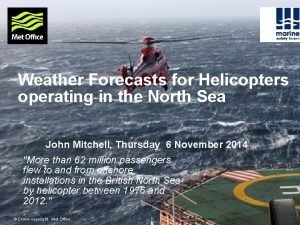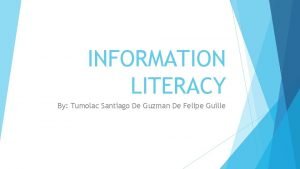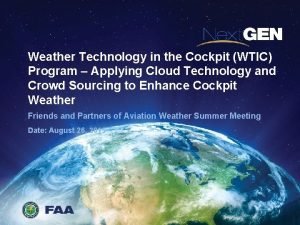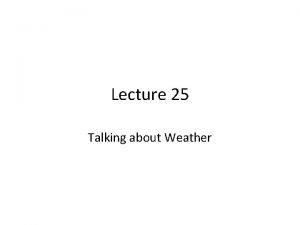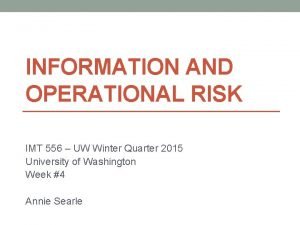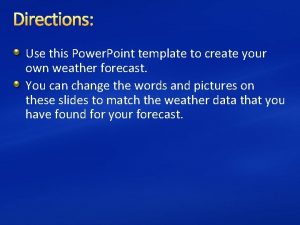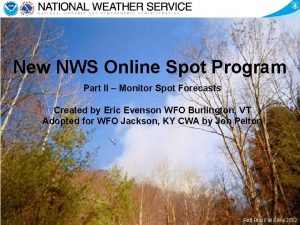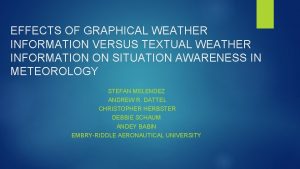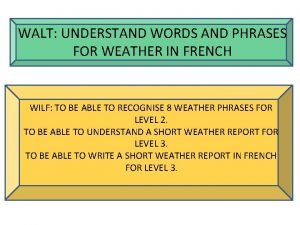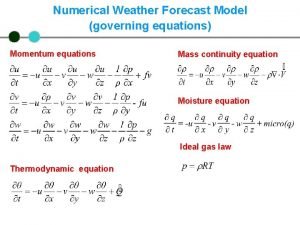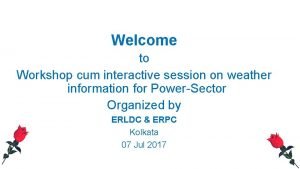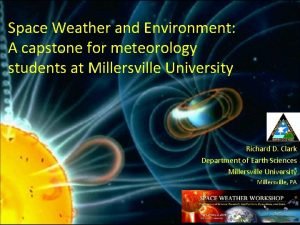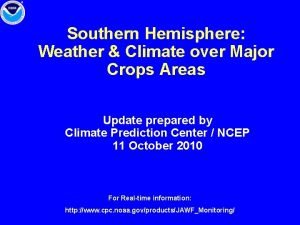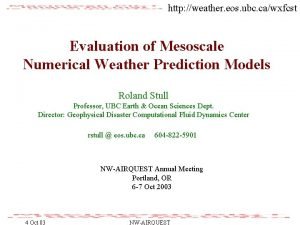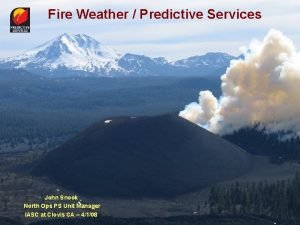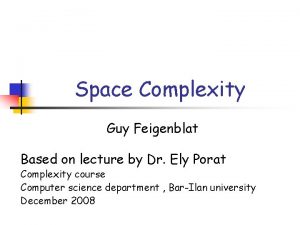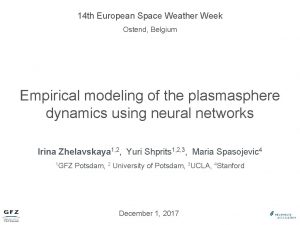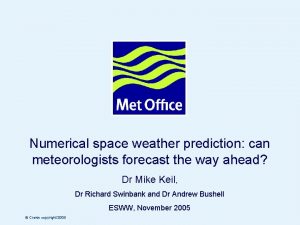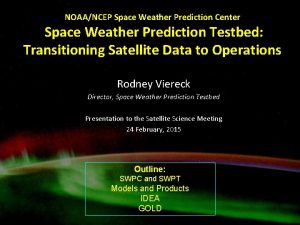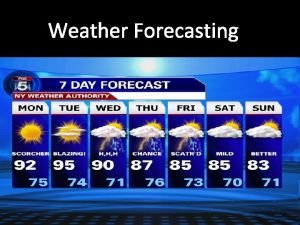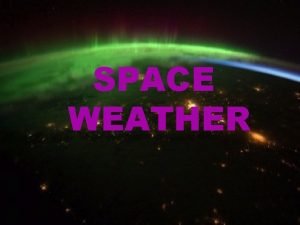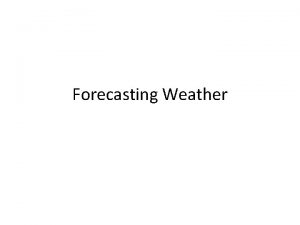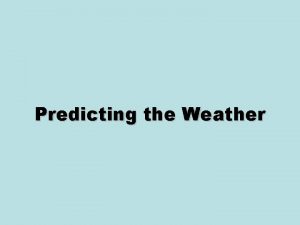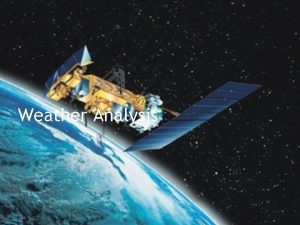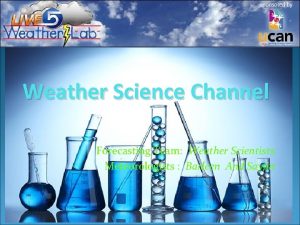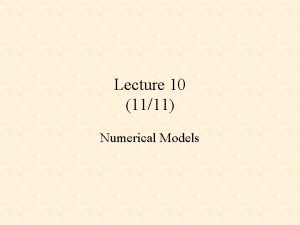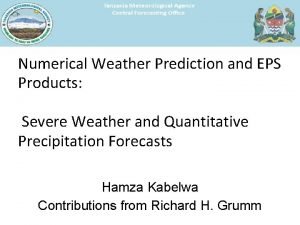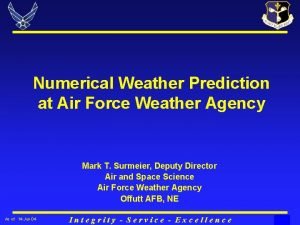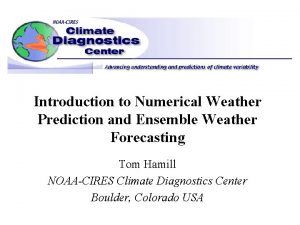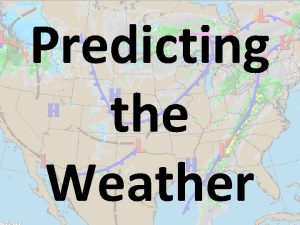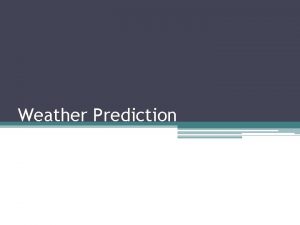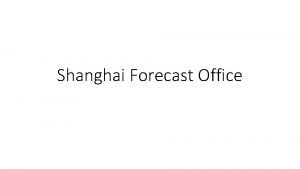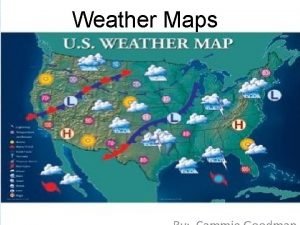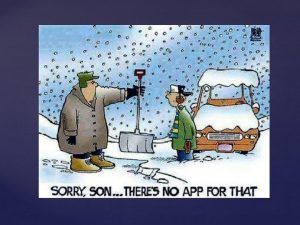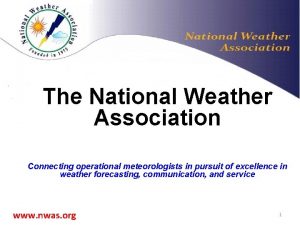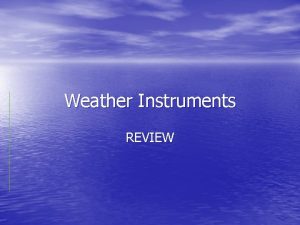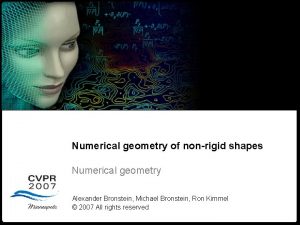Numerical space weather prediction can meteorologists forecast the

























- Slides: 25

Numerical space weather prediction: can meteorologists forecast the way ahead? Dr Mike Keil, Dr Richard Swinbank and Dr Andrew Bushell ESWW, November 2005 © Crown copyright 2005 Page 1

Introduction • What National Met Services (NMS) do and how does this fit in with Space Weather? • How did they get there? • What can be learned for Numerical Space Weather Prediction? • What does the future hold? © Crown copyright 2005 Page 2

National Met Services What do they do? © Crown copyright 2005 Page 3

How’s it done? Numerical Weather Prediction data assimilation Observations Model T+… T+48 T+24 T+12 T+6 T+5 T+4 T+3 T+2 T+1 Analysis © Crown copyright 2005 Forecast Page 4

Development of NWP: Vilhelm Bjerknes (1862 -1951) had a vision! L. F. Richardson’s first forecast sometime between 1916 and 1918. 1950 Charney ran the first forecast on a computer It took longer to subjectively quantify the ICs than run the forecasts! So far, no mention of Data Assimilation… Clearly a need for an objective way of specifying the initial conditions and analysis © Crown copyright 2005 Page 5

Development of DA: • 1949 Panofski had been creating objective analysis using interpolation techniques • 1954 Gilchrist and Cressman had two ideas: • numerical forecasts as a source of background info • automatic quality control of data • 1955 Bergothorsson and Doos – analyse observation increments • 1961 Thompson – use DA to propagate info into data voids © Crown copyright 2005 Page 6

NWP in the present day: • Development of NWP models and increased computer performance has led to more sophisticated assimilation schemes State Corrected forecast Initial forecast Observations T+0 © Crown copyright 2005 T+6 Time Page 7

The virtuous cycle observations science assimilation modelling © Crown copyright 2005 Page 8

1953 Storm © Crown copyright 2005 Page 9

The virtuous cycle observations science assimilation modelling © Crown copyright 2005 Page 10

Lessons from Numerical Weather Prediction § Data Assimilation combines information from observations with a background state. § The background state could come from a number of sources: subjective analysis, climatological averages, empirical models § To exploit the full potential of data assimilation, the background state should be produced using a physically-based numerical model. § This should be the approach to follow for SW assimilation © Crown copyright 2005 Page 11

Lessons from Numerical Weather Prediction § A physically-based numerical model is not just required for data assimilation. § A physically-based model is an essential part in fully establishing the virtuous cycle. § Empirical models can serve a useful purpose; however their potential for development is restricted. § Physically-based models provide a route for long-term space weather scientific growth © Crown copyright 2005 Page 12

Lessons – data issues NMS have experience in handling and processing vast amounts of data § Satellite data is the most obvious crossover area § Co-ordination is handled by WMO § Global Observing System § info / education / transition § Most NMS assimilate data from around 25 operational satellites §What about experimental satellites? §WMO set the “rules” § GTS infrastructure © Crown copyright 2005 Page 13

Lessons – common data sources GPS RO observations is a good example Mid-90 s humidity and temperature profiles from GPS Realistic assimilation first carried out at the Met Office Operational use next year Techniques can be applied to assimilate TEC COSMIC: Constellation Observing System for Meteorology, Ionosphere and Climate 6 space craft – provide TEC, allow operational monitoring Data available in near real time for scientific research © Crown copyright 2005 Page 14

Lessons – other questions along the way There are issues relevant to SW that have already been tackled by the met community: § Bias correction of data § Assimilation of derived products or raw values? § Pain before the gain – increasing complexity § Potential for development § Timeliness of data § Ensembles © Crown copyright 2005 Page 15

The future: operational met models Most operational met models are pushing beyond the stratosphere § Why? § Met Office global model will have a lid at 63 km § Research model with a 86 km lid § Other centres go higher – eg CMAM 210 km § Sensible to have a joined-up approach to common issues © Crown copyright 2005 Page 16

The future: scientific collaboration The Met Office are interested in Space Weather science! Potential areas of research: § Coupling between weather and space weather models § Lower boundary forcings? § Upwards/downwards control? § Fully coupled models (whole atmosphere approach)? § Applying data assimilation expertise to space weather assimilation § Radio occultation assimilation experience § Funding © Crown copyright 2005 Page 17

The future: numerical space weather prediction Within a decade (? ) there will be a requirement for operational numerical space weather prediction § Why? Primarily military with commercial applications § How? § Following the framework used in operational NWP § Learning from met experience in key areas § Utilising the facilities of NMS eg supercomputers, observation supply, 24/7 capabilities, down-stream dissemination to end users § This way of working already exists in operational oceanography at the Met Office © Crown copyright 2005 Page 18

Conclusions § The development over many years of NWP presents a framework for Numerical Space Weather Prediction § Fully establish the “virtuous cycle” for SW § Some pain can be avoided by learning from the met community! § Science can be pushed forward through collaboration § Operational Space Weather within a decade? § National Met Services offer crucial facilities § Successful partnerships of this kind already exist § Thanks for listening! © Crown copyright 2005 Page 19

Questions © Crown copyright 2005 Page 20

The framework of modern DA: Panofski Bergothorsson and Doos Gilchrist and Cressman data assimilation Model Observations Thompson Forecast Analysis © Crown copyright 2005 T+6 T+5 T+4 T+3 T+2 T+1 Bjerknes / Richardson / Charney Page 21

DA: hierarchy § Most assimilation schemes operate sequentially. § As long as the evolution of errors is close to linear, an extended Kalman filter is the optimum statistical assimilation method. § Hierarchy of different approximations to the Kalman filter: § § § Direct insertion Nudging Statistical interpolation 3 D-variational (old Met Office system) 4 D-variational (current Met Office global system) Ensemble Kalman Filter § Choose appropriate level of complexity / cost. © Crown copyright 2005 Page 22

DA: cost function § Analysis is found by minimising a cost function quantifying misfit between model fields x and both obs yo and background xb Where y=H(x) is a prediction of yo § In 3 D-VAR, the analysis is calculated using observations at one particular time § In 4 D-VAR, the analysis uses observations at their correct validity time § Met Office system written in incremental form © Crown copyright 2005 Page 23

DA: 4 D Var § 4 D-VAR uses observations over a given time window. § Allows use of observations at correct time, and exploit information in a time sequence. § Requires use of a (simplified, linear) model and its adjoint. (Not clear what level of simplification is appropriate for ionosphere). © Crown copyright 2005 Page 24

DA: summary § 3 DVAR (with a 6 h assimilation cycle for global model) currently used for the stratospheric version of the UM. 4 D VAR in the global model was implemented during 2004. § Main advantage of 4 DVAR is use of observations at correct time / use of time sequence of obs. Requires adjoint of forecast model. (3 DVAR only requires adjoint of observation operator. ) § Kalman Filter updates error covariance as well as state – much more expensive; requires drastic simplification. © Crown copyright 2005 Page 25
 Penn state meteorologists
Penn state meteorologists Helicopter weather forecast
Helicopter weather forecast According to the weather forecast there is no typhoon
According to the weather forecast there is no typhoon Weather forecast lesson 3 outline answers
Weather forecast lesson 3 outline answers Wtic weather
Wtic weather How's the weather
How's the weather Imt 556
Imt 556 Create a weather forecast template
Create a weather forecast template Nws pad
Nws pad Graphical weather forecast
Graphical weather forecast French weather phrases
French weather phrases Weather equations
Weather equations Weather forecast udumalpet next 14 days
Weather forecast udumalpet next 14 days Millersville university weather forecast
Millersville university weather forecast Southern hemisphere weather forecast
Southern hemisphere weather forecast Ubc weather
Ubc weather Weather predictive services
Weather predictive services Station model and weather symbols
Station model and weather symbols Whether the weather tongue twister
Whether the weather tongue twister Poem fashion
Poem fashion It's sunny and windy
It's sunny and windy Whether the weather be fine
Whether the weather be fine Heavy weather by weather report
Heavy weather by weather report Capital weather gang weather wall
Capital weather gang weather wall Space weather family guy
Space weather family guy European space weather week
European space weather week

